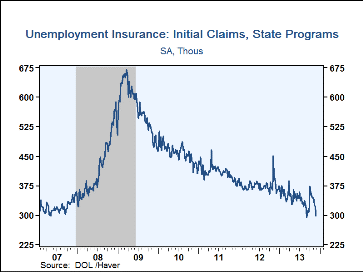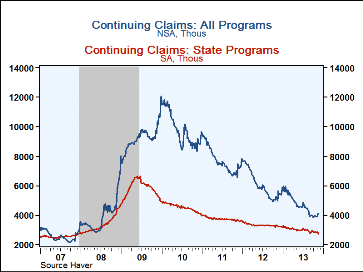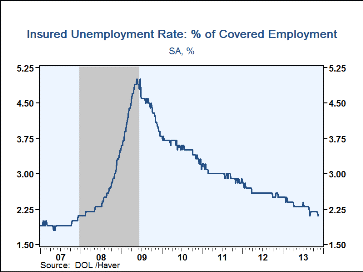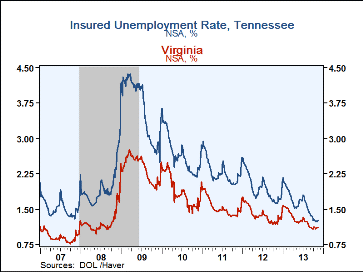 Global| Dec 05 2013
Global| Dec 05 2013U.S. Initial Claims for Unemployment Insurance Near 2007 Low
by:Tom Moeller
|in:Economy in Brief
Summary
The rate of labor market improvement is strengthening. Initial claims for unemployment insurance fell to 298,000 last week (-19.5% y/y) following an unrevised 316,000 during the week ended November 23. It was nearly the lowest level [...]
The rate of labor market improvement is strengthening. Initial claims for unemployment insurance fell to 298,000 last week (-19.5% y/y) following an unrevised 316,000 during the week ended November 23. It was nearly the lowest level since just before the last recession. The decline outpaced consensus expectations for 320,000 claims while the four week moving average of claims fell to 322,250.
Continuing claims for unemployment insurance in the week ended November 23 declined to a new low of 2.744 million (-14.7% y/y). The four-week moving average of continuing claims fell to 2.797 million. The insured rate of unemployment held at 2.1%. This particular count covers only "regular" programs and does not include all extended benefit and other specialized jobless insurance programs. In the week of November 16, the latest available, the total of all benefit recipients ticked up to 4.097 million (-17.4% y/y). This broader measure is not seasonally adjusted. It compares to a cycle peak of 12.060 million in January 2010 and pre-recession figures that averaged 2.596 million for 2007. The number of individuals collecting emergency and extended payments in the week of November 16 ticked up to 1.351 million (-32.8% y/y).
By state, the insured rate of unemployment continued to vary greatly with Virginia (1.12), New Hampshire (1.17%), Tennessee (1.26%), Florida (1.30%), Ohio (1.47%), Texas 1.49%) and Vermont (1.71%) at the low end of the range. At the high end were the District of Columbia (2.37%), Illinois (2.52%), Pennsylvania (2.89%), Connecticut (2.82%), California (3.10%) and New Jersey (3.22%). These data are not seasonally adjusted.
Data on weekly unemployment insurance are contained in Haver's WEEKLY database and they are summarized monthly in USECON. Data for individual states are in REGIONW. The consensus estimates come from the Action Economics survey, carried in the AS1REPNA database.
| Unemployment Insurance (000s) | 11/30/13 | 11/23/13 | 11/16/13 | Y/Y % | 2012 | 2011 | 2010 |
|---|---|---|---|---|---|---|---|
| Initial Claims | 298 | 316 | 326 | -19.5 | 375 | 409 | 459 |
| Continuing Claims | -- | 2,744 | 2,765 | -14.7 | 3,319 | 3,742 | 4,531 |
| Insured Unemployment Rate (%) | -- | 2.1 | 2.1 | 2.6 (11/12) |
2.6 | 3.0 | 3.6 |
| Total "All Programs" (NSA) | -- | -- | 4.097 mil. | -17.4 | 6.049 mil. | 7.724 mil. | 9.825 mil. |
Tom Moeller
AuthorMore in Author Profile »Prior to joining Haver Analytics in 2000, Mr. Moeller worked as the Economist at Chancellor Capital Management from 1985 to 1999. There, he developed comprehensive economic forecasts and interpreted economic data for equity and fixed income portfolio managers. Also at Chancellor, Mr. Moeller worked as an equity analyst and was responsible for researching and rating companies in the economically sensitive automobile and housing industries for investment in Chancellor’s equity portfolio. Prior to joining Chancellor, Mr. Moeller was an Economist at Citibank from 1979 to 1984. He also analyzed pricing behavior in the metals industry for the Council on Wage and Price Stability in Washington, D.C. In 1999, Mr. Moeller received the award for most accurate forecast from the Forecasters' Club of New York. From 1990 to 1992 he was President of the New York Association for Business Economists. Mr. Moeller earned an M.B.A. in Finance from Fordham University, where he graduated in 1987. He holds a Bachelor of Arts in Economics from George Washington University.










